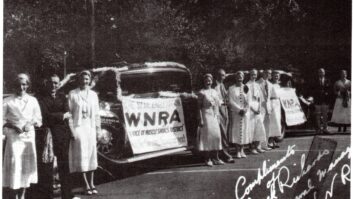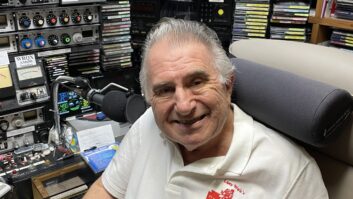
In 2011, WSM’s diamond shaped tower was added to the National Register of Historic Places by the U.S. Department of the Interior.
A lot has changed in 90 years in both the radio industry and the world in general, but one constant for the people of Nashville has been WSM 650 AM and country music. Now owned by Ryman Hospitality Properties (the former Gaylord Entertainment Co.), the station this month celebrated its 90th birthday and a rich history, including its relationship with country pioneer the “Grand Ole Opry” — which the station spawned — as well as WSM’s distinguished diamond-shaped tower.
Radio World emailed with General Manager Chris Kulick, Promotions Manager Nicole Judd and former and current Chief Engineers Watt Hairston and Jason Cooper about how it celebrated the big 9-0. Replies are synthesized from their answers. All accompanying photos are from the station’s Facebook page.
Radio World: What did WSM do to celebrate the anniversary?
We celebrated 90 years of broadcasting with a four-day celebration. Events included special on-air content, live shows and listener winning opportunities; the celebration culminated with a community open house at the station’s famous Blaw-Knox tower site on Mon., Oct. 5.
Highlights of WSM’s schedule included “90 for 90,” where WSM surveyed listeners and country artists to compile their favorite 90 songs from the station’s 90-year history. Several of those favorites were featured during the Oct. 1 “Opry Country Classics” airing live from the Ryman Auditorium, including “All The Gold (In California)” by show host Larry Gatlin and the Gatlin Brothers and “Don’t it Make My Brown Eyes Blue” by Spotlight Artist Crystal Gayle. The 90 favorites were heard on-air throughout the weekend and during a countdown of all 90 songs on Oct. 5.
There was also “Coffee, Country & Cody” WSM morning man Bill Cody’s show live from the stage of the Grand Ole Opry. Guests included Country Music Hall of Famers The Oak Ridge Boys, Grand Ole Opry members Old Crow Medicine Show, and Charles Esten, star of ABC’s “Nashville.”
Fifty lucky listeners participated in on-air and online contesting to win tickets to be part of the special on-stage broadcast.
The First Annual Grand Ole Chili Cook Off took place on Oct. 3 on the Grand Ole Opry Plaza during Birthday Bash Weekend. Cash prizes were awarded for first, second and third place, and crowd favorite winners.

General Manager Chris Kulick, former WSM General Manager Bob Meyer, and WSM’s Eddie
Lastly, listeners and fans were invited to attend a community open house at the station’s famous Blaw-Knox tower site in Brentwood, Tenn. Guests toured the historic transmitter facility, met past and present WSM air personalities, and enjoyed free lunch and birthday cake on the grounds.
RW: How has WSM changed in 90 years?
Well, we’ve certainly come a long way from Nashvillians gathering beneath loudspeakers mounted on the corner of Seventh and Union in downtown Nashville, or crouched over their improvised radio sets at home listening over ear pieces. Now you can take WSM with you wherever you go. We’re still tried and true on 650 AM, but we now have a 24/7 online stream available at WSMonline.com, as well as a free mobile app.
RW: How many employees does the station have today?
Twenty-five.
RW: It certainly seems like WSM puts a special emphasis on its history, why is that? What role does that history play today?
WSM has been on the air since 1925 and has been the flagship of country music. WSM and the Grand Ole Opry are two of the reasons that Nashville became the center of country music. We at WSM feel that we’re the caretakers of this great institution and it’s our responsibility to preserve the history of those that came before us, as well as embrace the future for those that will come after.

Visitors tour the Transmitter Building and look at special historical archives from years gone by.
(Read a history of the station.)
RW: What does WSM have planned for the future?
It’s our goal each day to share country, bluegrass and Americana music, as well as the excitement of Music City with friends in Middle Tennessee and listeners around the world.
RW: WSM is unusual as a big-signal AM that still plays music in 2015. Why does this work for WSM when so many other big AM stations have moved away from that formula?
WSM is an iconic brand and remains relevant as a player in country music. As FM stations continue to narrow playlists, and shorten artist interviews, we play new music and welcome up and coming acts. We work hand in hand with the Grand Ole Opry to support new artists.

Former WSM Chief Engineer Watt Hairston and Teea Goans.
RW: Chris, what is your position on the AM revitalization initiative going on at the FCC?
The fact that the FCC is paying attention to this issue is encouraging. There are still many details to be worked out. I look forward to going through the process.
RW: As part of that debate, iHeartMedia has expressed concerns to the FCC about protecting Class A signals at night. Given your big signal footprint at night, where does WSM come down on this?
At this time, I have no comment.
RW: Turning to the engineers: It has now become well known, but why did the station decide to go with a diamond shape for the tower?
There are two different design considerations regarding the WSM tower: structural-mechanical and electrical-electromagnetic.
From a structural and mechanical perspective, a tower like this must be able to support not only its own weight but also the stresses and loads presented by wind, temperature and weather conditions. The guying system is complex as it must hold the structure upright while not overloading the lower supports with too much weight.

Radian Corp.’s Jason Cooper gives a tour of the tuning house and tower base to a group of interested visitors. Radian provides engineering services to WSM.
For a time, the WSM tower was the tallest guyed mast in the world. The engineering that was involved during that period was limited by the sheer number of calculations to consider all the stresses and loads. U.S. Steel provided Blaw-Knox with all the design details and calculations that were essentially provided by rooms of engineers conducting the calculations using log tables, mechanical calculators and long-hand math. It was a slow and tedious process.
The WSM tower is guyed by one set of eight guy cables attached at the mid-point. Above this point, the tower is self-supporting. Below this point, the structure tapers to a pivot point at the base insulator. This method reduces the twisting stress through the use of a hinge allowing the tower to freely turn on the pivot point where the tower must be electrically insulated from ground. The wide girth of the tower at the middle, is to terminate the eight guywires that are pulling a total of 440,000 pounds on the tower and the weight plus stress for the upper free-standing part of the tower. The bottom of the tower is a linear taper from the midsection down to the base insulator. The top part of the tower is not linear; there is a pitch change at the 680-foot level.
From an electrical standpoint, the tower must be of sufficient length to produce the amount of field intensity when fed with the necessary driving power as required by FCC rules for this specific class of station defined as “Class A.” The tower itself, being the antenna, must also be insulated from ground by the guy wires and base insulator. The tower is centered over a counterpoise that consist of approximately 120 radials that extend uniformly from the base of the tower out to a distance of approximately 100 electrical degrees. When fed with radio frequency energy from the transmitter through a transmission line and impedance matching circuitry, the electrostatic interaction between the tower and the ground system creates an alternating electromagnetic wave in the atmosphere.
This phenomenon was envisioned by James Clerk Maxwell, a Scottish physicist in the middle 1800s, proven by Nicola Tesla and adapted for broadcast use by noted RCA engineers Dr. G.H. Brown, R.F. Lewis and J. Epstein.

The Blaw-Knox Dual cantilevered tower as a structure fit the geometry need of a suitable antenna but was primarily designed from a structural standpoint. Even though Blaw-Knox touted the electrical superiority of the shape of the tower, it was proven to be a detriment later on. In the early 1940s, WSM and WLW both realized their towers were too tall, appearing to be longer electrically than they were physically. This caused them to interfere with themselves, hampering coverage in some areas distant from the antenna. Accordingly, the physical heights were adjusted downward to compensate for the effect the ~35-foot girth at the middle of the tower where the guywires attach. In the case of WSM, the height was reduced by 70 feet by lowering part of the mast and removing the top sections. The added length was causing an unwanted secondary lobe to appear at an elevation of ~57 electrical degrees in the vertical pattern.
See dozens of photos from the tower site open house on the WSM Facebook page.












